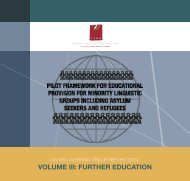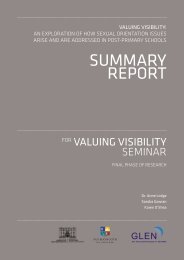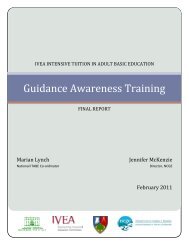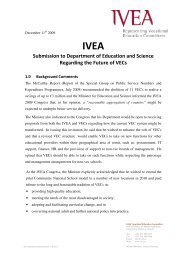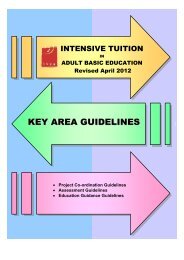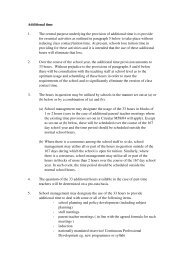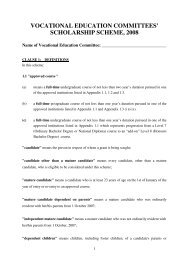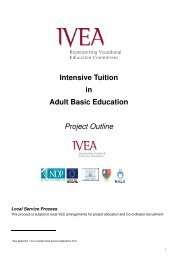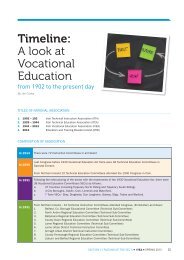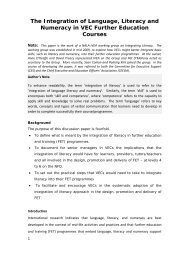Download File - IVEA
Download File - IVEA
Download File - IVEA
Create successful ePaper yourself
Turn your PDF publications into a flip-book with our unique Google optimized e-Paper software.
4 LEGAL AND POLICY CONTEXT<br />
4.1 THE INTERNATIONAL DIMENSION<br />
International public law incorporates European Union (EU) 30 law and<br />
international agreements/instruments. EU law is supranational in<br />
character and supersedes domestic law. EU law is legally binding<br />
and consists of Treaties, Directives, Regulations and European Court<br />
of Justice decisions. In addition, EU Resolutions, while not legally<br />
binding, influence national government policy in the Member States.<br />
The most effective human rights instrument in Europe, the European<br />
Convention on Human Rights (1950) is an international treaty of the<br />
Council of Europe 31 . Formed at the end of World War II, the Council<br />
of Europe is a pan-European intergovernmental organisation.<br />
The First Protocol (which deals with education) was added to the<br />
Convention because the original document did not include Articles<br />
concerning education.<br />
Article 2 of Protocol 1 reads:<br />
No person shall be denied the right to education. In the<br />
exercise of any functions which it assumed in relation to<br />
education and to teaching, the State shall respect the right of<br />
parents to ensure such education and teaching in conformity<br />
with their own religious and philosophical convictions.<br />
Article 2 provides, in its initial sentence, that the State shall not<br />
deny any person the right to education. The State cannot interfere<br />
with an individual’s exercise of the right to education, by excluding<br />
them from State provided educational opportunities. According<br />
to Glendenning 32 , if challenged, the State is in a stronger position<br />
rather than if the duty were affirmatively stated. The burden is on<br />
the individual to prove they have been denied access to specific<br />
educational provision. Moreover, the second sentence of Article 2<br />
provides the State with some discretion with regard to education and<br />
teaching. “Generally, this indicates that the State is not obligated<br />
to establish certain types of educational opportunities or to ensure<br />
that each person achieves the education he or she desires” 33 .<br />
The Convention was incorporated into domestic law when the<br />
European Convention on Human Rights Act, 2003 was enacted in<br />
December 2003. The Irish Government has chosen an interpretative<br />
model whereby the Irish Courts will be expected to interpret the<br />
Convention in accordance with the Irish Constitution. Courts can<br />
also make a ‘declaration of incompatibility’ when a clause of the<br />
Convention is deemed contrary to existing legislation or practice.<br />
This is an important development for the education sector and<br />
provides a human rights dimension to Irish education legislation.<br />
In addition, the Ombudsman for Children Act, 2002 came into effect<br />
in early 2004 making, for the first time, the Convention on the Rights<br />
of the Child 34 (1989) recognisable in Irish law.<br />
International human rights instruments have a persuasive impact<br />
upon signatory countries, for example: the United Nations Convention<br />
on Economic and Social Rights (1976).<br />
4.2 THE NATIONAL DIMENSION<br />
National or domestic law comprises Bunreacht na hÉireann (the<br />
Constitution of Ireland), Irish statute law and Irish case law. In the<br />
context of this document, the most significant sources are Bunreacht<br />
na hÉireann (Constitution of Ireland); the Education Act, 1998; the<br />
Education (Welfare) Act, 2000; the Equal Status Act, 2000; the<br />
Ombudsman for Children Act, 2002; and the Vocational Education<br />
(Amendment) Act, 2001 (refer to Appendix III for salient features).<br />
(a) Bunreacht na hÉireann/The Irish Constitution<br />
Article 42 of the Constitution deals with education, but its purpose<br />
is to assert the primacy of the family in the sphere of education.<br />
The Irish Constitution has almost no conception of the child as an<br />
individual with rights independent of its parents or the State. This<br />
concept is only alluded to in the last sentence of Article 42.5, which<br />
refers to ‘the natural and imprescriptible rights of the child’,<br />
but there is no elaboration on what these rights are. The National<br />
Children’s Strategy (discussed below) is designed to ameliorate<br />
this anomaly.<br />
(b) The Education Act, 1998<br />
This is the most important source of law for this framework from<br />
a practical point of view. Schools, teachers and VECs must keep<br />
in mind its provisions, and particularly bear in mind that there is no<br />
distinction between citizens of the State and non-citizens in relation<br />
to the provision of education and right to receive it.<br />
(c) The Education (Welfare) Act, 2000<br />
The purpose of this Act is to ensure that everyone of the relevant<br />
age receives an education either in a recognised school or in<br />
an acceptable alternative setting. Essentially promoting school<br />
16<br />
30<br />
EU Member States: Austria; Belgium; Cyprus; Czech Republic; Denmark; Estonia; Finland; France; Germany; Greece; Hungary; Ireland; Italy; Latvia; Lithuania; Luxembourg; Malta; Poland; Portugal; Slovakia; Slovenia; Spain;<br />
Sweden; The Netherlands; and the United Kingdom.<br />
31<br />
The Council of Europe is comprised of the forty-six members States including all the EU Members States together with Albania; Andorra; Armenia; Azerbaijan; Bosnia and Herzegovia; Bulgaria; Croatia; Georgia; Iceland; Liechtenstein;<br />
the former Yugoslav Republic of Macedonia; Moldova; Monaco; Norway; Romania; Russian Federation; San Marino; Serbia and Montenegro; Switzerland; Turkey; and the Ukraine. The Council of Europe strives to promote Europe’s cultural<br />
identity and diversity, combats discrimination and social exclusion as well as promoting democratic stability.<br />
32<br />
Glendenning, D. Education and the Law Butterworks, Dublin: 1999.<br />
33<br />
Ibid.<br />
34<br />
Article 2(1) of the International Convention on the Rights of the Child 1989, signed by Ireland 30 September 1990 and ratified 28 September 1992.



